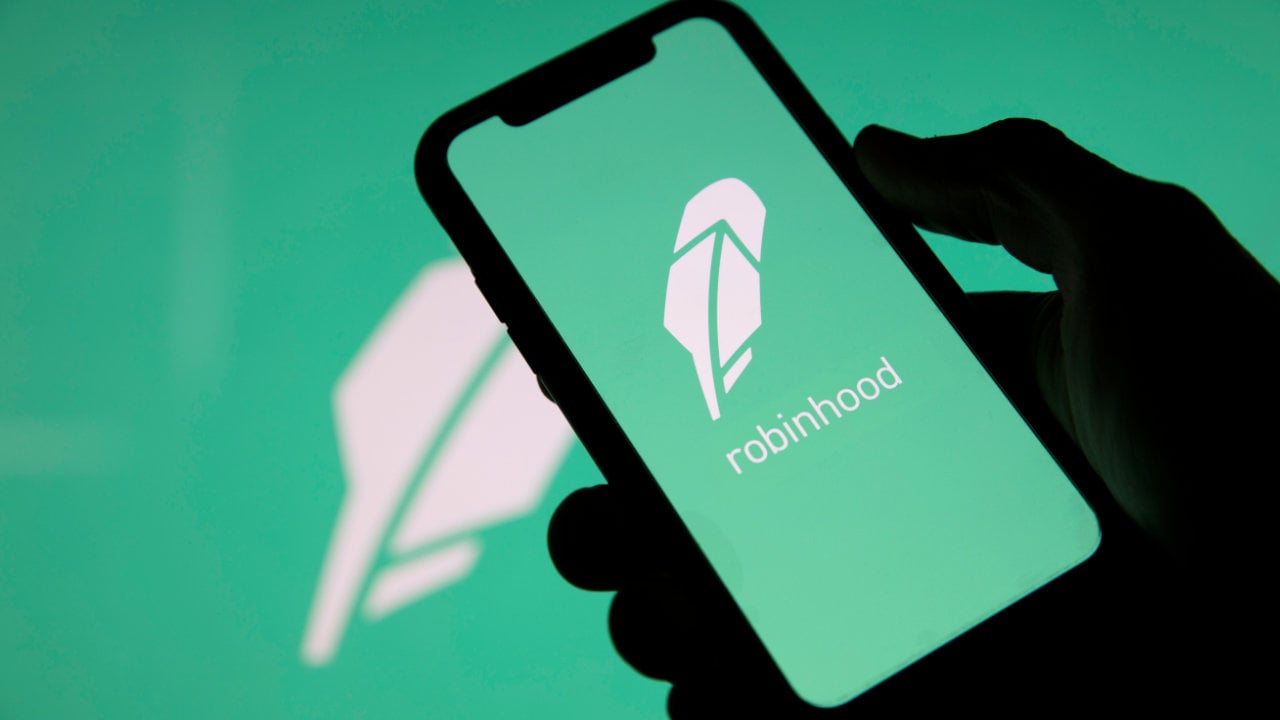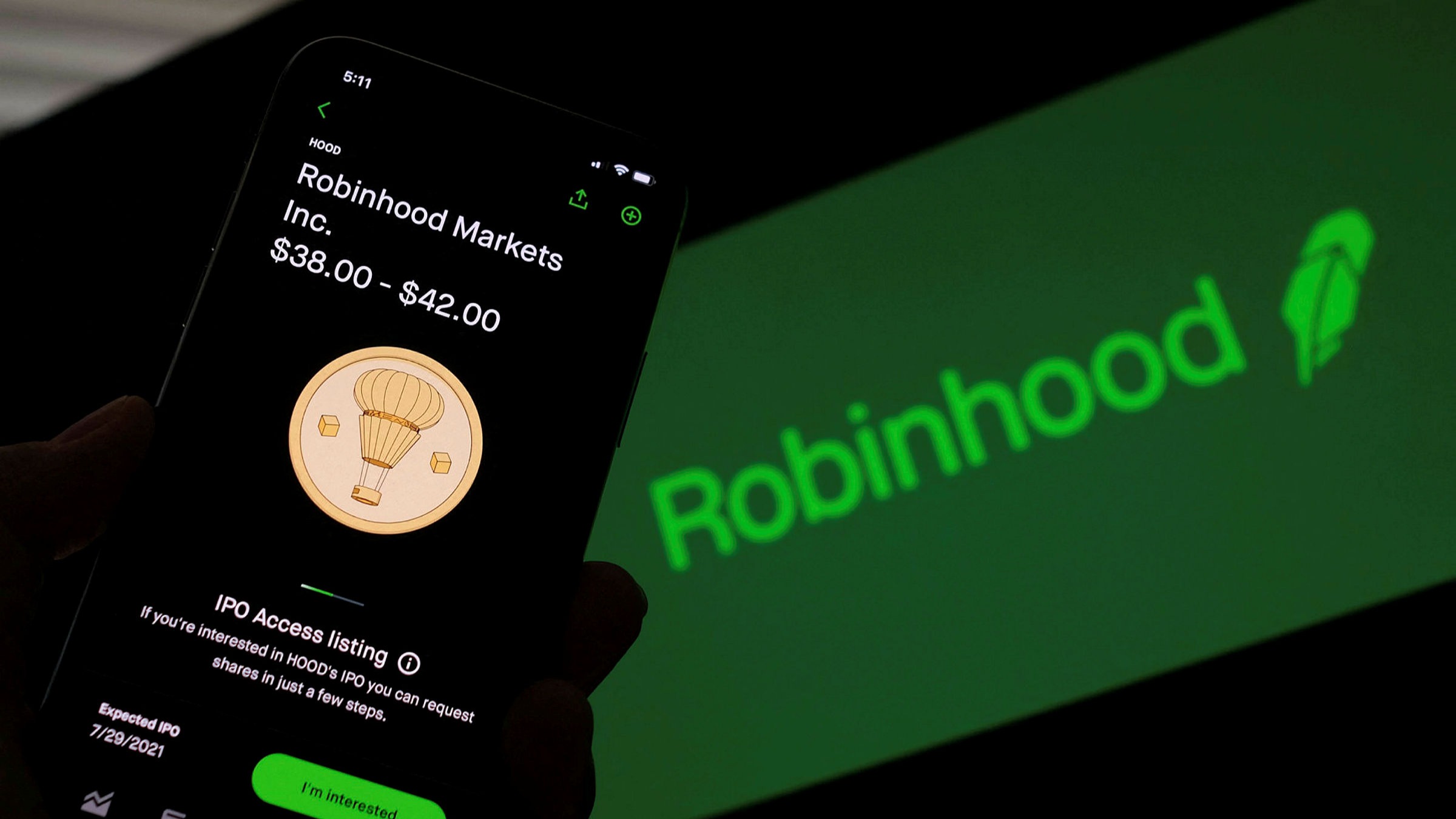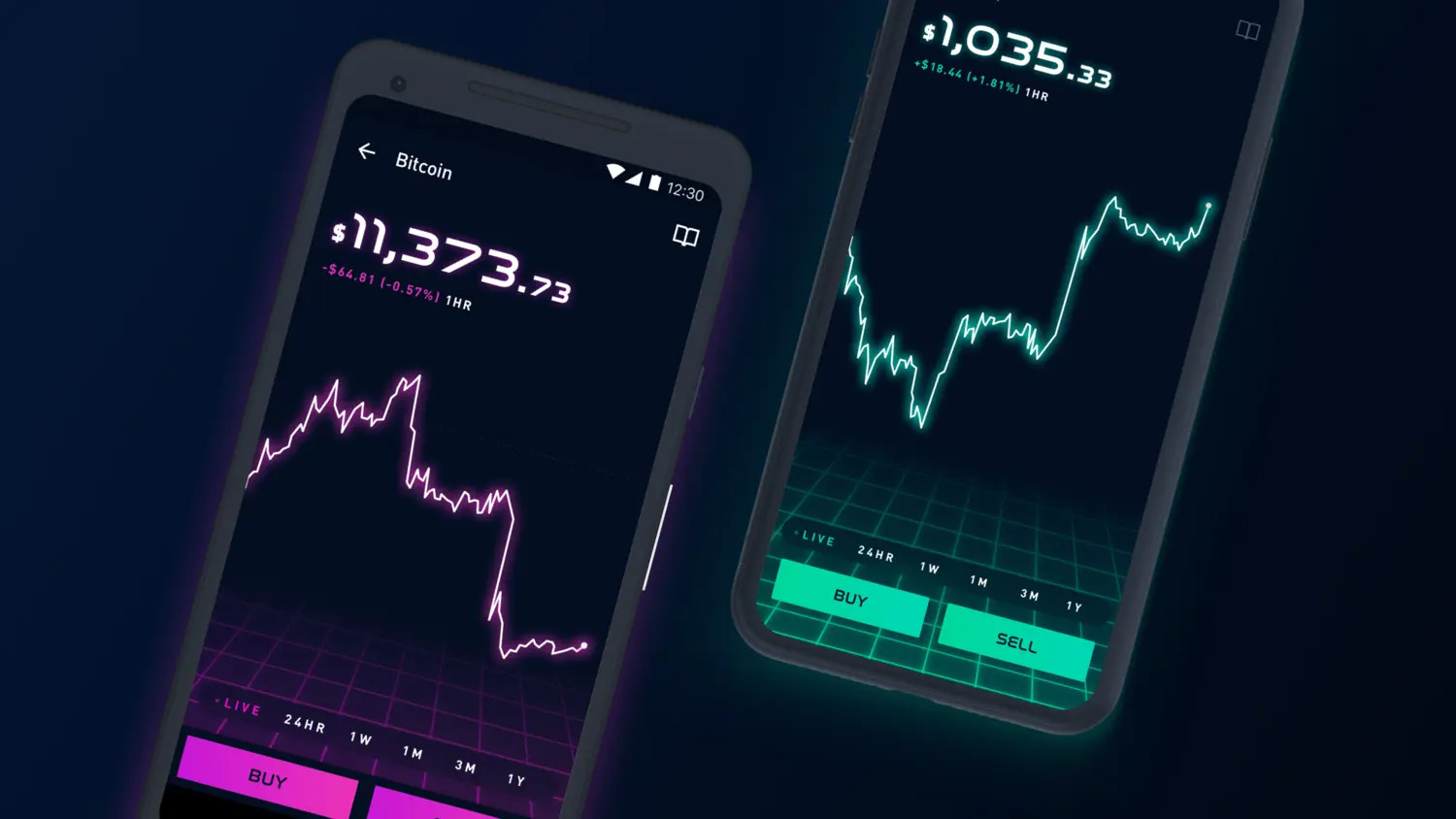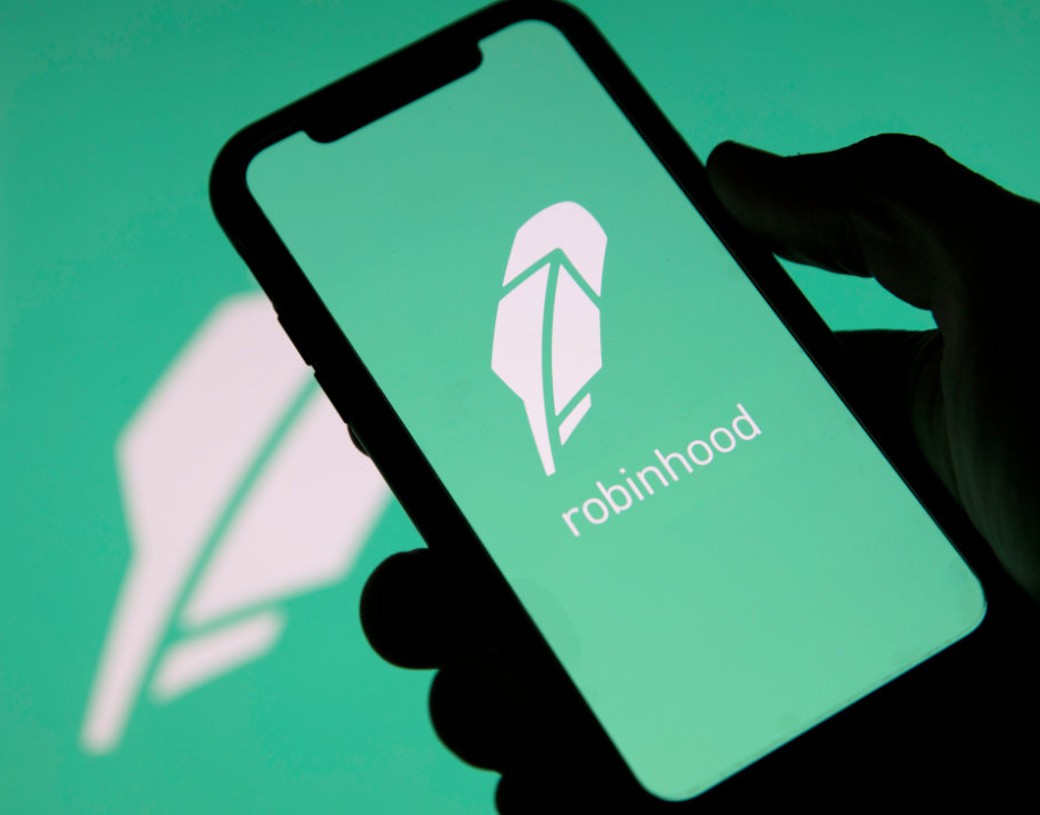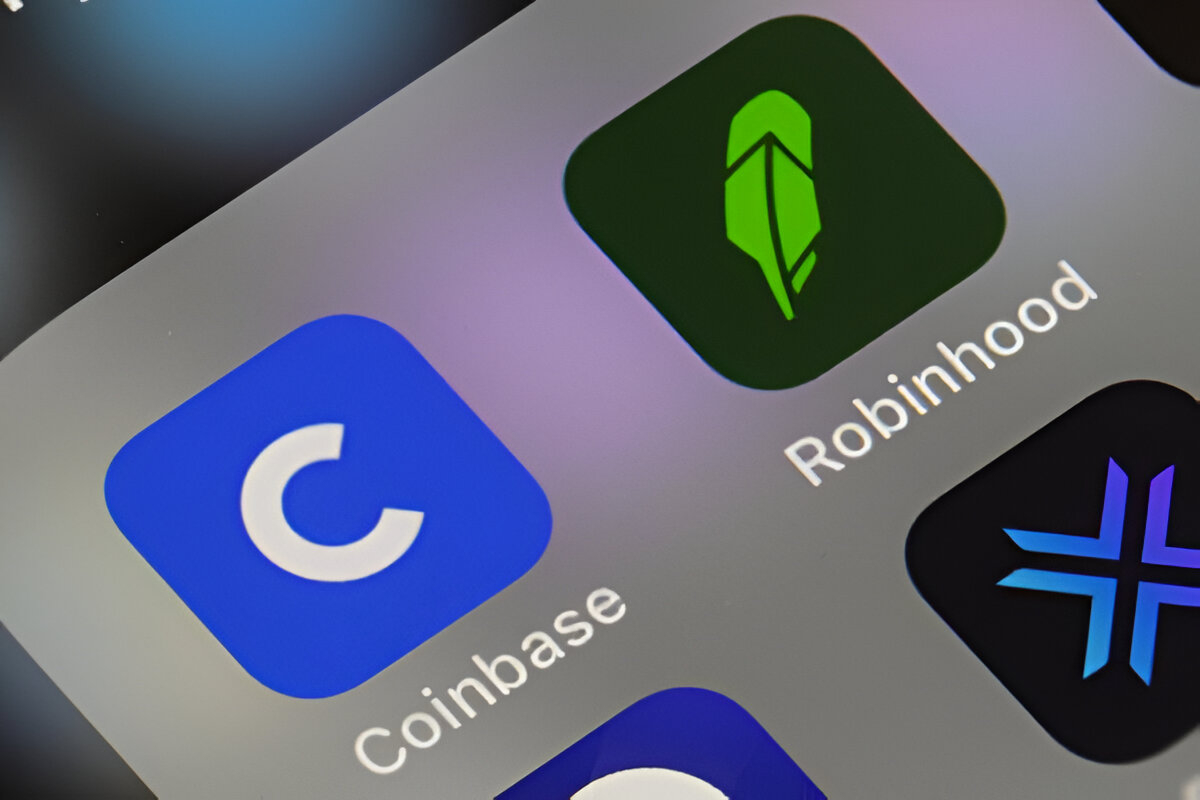Introduction
Welcome to the world of cryptocurrency! With the rise of digital currencies, more and more platforms are offering ways to trade and invest in various crypto assets. One such platform is Robinhood, a popular commission-free trading app that has gained significant traction in recent years.
Robinhood aims to democratize finance by providing access to a wide range of financial instruments, including cryptocurrencies. This allows users to easily buy, sell, and trade crypto assets directly from their Robinhood accounts. Whether you’re a seasoned investor or just starting out, Robinhood offers a user-friendly interface and a diverse selection of cryptocurrencies to explore.
In this article, we’ll take a closer look at some of the cryptocurrencies available on Robinhood. We’ll explore their features, potential uses, and their ranking in the overall cryptocurrency market.
It’s important to note that the cryptocurrency market is highly volatile and constantly evolving. Prices can fluctuate dramatically, and investing in cryptocurrencies carries inherent risks. It’s crucial to do your own research, understand the market dynamics, and carefully consider your investment goals and risk tolerance before diving into the world of crypto.
Now, let’s delve into some of the cryptocurrencies you can trade on Robinhood.
Bitcoin (BTC)
Bitcoin is the first and most well-known cryptocurrency, often referred to as the king of digital currencies. Created in 2009 by an anonymous person or group of people known as Satoshi Nakamoto, Bitcoin operates on a decentralized network called the blockchain. It revolutionized the financial industry by introducing a peer-to-peer electronic cash system that is not controlled by any central authority.
Bitcoin offers several key advantages that have contributed to its popularity. Firstly, it provides users with the ability to send and receive money across borders quickly and at a lower cost compared to traditional banking systems. Additionally, Bitcoin transactions are pseudonymous, providing a certain level of privacy for users.
As the most valuable cryptocurrency by market capitalization, Bitcoin has garnered significant attention from investors and traders worldwide. Its price volatility allows for potential profit opportunities, but it also means there are risks involved. It’s important to keep in mind that investing in Bitcoin should be approached with caution.
Bitcoin’s underlying technology, blockchain, is seen as a groundbreaking innovation. It has sparked interest in various industries beyond finance, including supply chain management, healthcare, and gaming, among others. The potential applications of blockchain technology are still being explored, with many experts believing it has the power to revolutionize multiple sectors.
While Bitcoin remains the dominant force in the cryptocurrency market, it faces challenges such as scalability and regulatory scrutiny. However, its resilience and widespread adoption continue to solidify its position as the poster child of cryptocurrencies.
In summary, Bitcoin is the pioneer of digital currencies, offering secure and decentralized transactions. Its potential for growth and its impact on the financial landscape make it a highly sought-after cryptocurrency for both investors and technology enthusiasts.
Ethereum (ETH)
Ethereum is a groundbreaking platform that enables the creation and management of decentralized applications (dApps) and smart contracts. Released in 2015 by Vitalik Buterin, Ethereum provides a more versatile and programmable infrastructure than Bitcoin, making it a significant player in the world of cryptocurrencies.
One of Ethereum’s key features is its ability to execute smart contracts automatically and securely, removing the need for intermediaries in many transactions. Smart contracts are self-executing contracts with predefined conditions written directly into the code. This technology opens up countless possibilities for disruption across various industries.
As the native cryptocurrency of the Ethereum platform, Ether (ETH) serves multiple purposes. Firstly, it acts as a medium of exchange for services and transactions within the network. Additionally, Ether is required to power computational operations on the Ethereum network, making it an essential element in the ecosystem.
Ethereum’s versatility has sparked immense interest among developers and entrepreneurs. It has facilitated the creation of numerous blockchain-based projects, including decentralized finance (DeFi) applications, non-fungible tokens (NFTs), and decentralized exchanges (DEXs).
The Ethereum community is known for its vibrant ecosystem and strong developer support. The platform has seen significant growth, with many developers and organizations building on top of Ethereum to create innovative and disruptive applications. This has further solidified Ethereum’s position as the second-largest cryptocurrency by market capitalization.
However, Ethereum faces its own challenges, primarily scalability and high gas fees during times of network congestion. To address these issues, Ethereum is undergoing an upgrade to Ethereum 2.0, aiming to introduce sharding and a more sustainable consensus mechanism.
Overall, Ethereum has proven to be a pioneer in the field of blockchain technology, enabling the development of decentralized applications and smart contracts. Its growing ecosystem and potential for disrupting various industries make it a fundamental cryptocurrency to watch.
Litecoin (LTC)
Litecoin, often referred to as the silver to Bitcoin’s gold, is a peer-to-peer cryptocurrency created by Charlie Lee in 2011. It was designed to be a faster and more affordable alternative to Bitcoin, aiming to improve upon some of its limitations.
One of the key differentiating factors of Litecoin is its transaction confirmation time. Unlike Bitcoin’s average block time of 10 minutes, Litecoin aims for a block time of 2.5 minutes, resulting in faster confirmation times for transactions. This makes Litecoin more suitable for day-to-day transactions and small-value transfers.
Litecoin also utilizes a different hashing algorithm than Bitcoin, known as Scrypt. This algorithm is considered to be more memory-intensive, which helps to maintain a decentralized mining ecosystem. It allows for a wider distribution of mining power among individuals, contributing to Litecoin’s goal of remaining accessible and resistant to centralization.
With its focus on speed and accessibility, Litecoin has gained traction as a cryptocurrency for everyday use. It has been integrated into various payment processors, allowing merchants to accept Litecoin as a form of payment. This further strengthens its utility and potential as a digital currency.
While Litecoin offers several advantages over Bitcoin, it is important to note that it still operates within the overall cryptocurrency market. Litecoin’s value is influenced by market factors and can experience significant volatility. Investors should exercise caution and conduct thorough research before considering any investment in Litecoin or any other digital asset.
Litecoin’s community and development team remain active, continuously working on improvements and updates. Despite facing competition from other cryptocurrencies, Litecoin has established itself as one of the longest-standing and respected projects in the crypto space.
In summary, Litecoin presents itself as a fast and accessible cryptocurrency, seeking to overcome some of the limitations of Bitcoin. With its emphasis on transaction speed and affordability, Litecoin is positioned as a digital currency suitable for everyday use and small-value transfers.
Bitcoin Cash (BCH)
Bitcoin Cash (BCH) emerged as a result of a hard fork in the Bitcoin blockchain in 2017. The fork was driven by the need to address scalability issues and improve transaction speed and cost. Bitcoin Cash aims to be a peer-to-peer electronic cash system that facilitates fast and low-cost transactions.
One of the key differences between Bitcoin Cash and Bitcoin is the block size limit. Bitcoin has a 1MB block size limit, while Bitcoin Cash increased it to 8MB. This allows for a greater number of transactions to be processed within each block and helps reduce congestion on the network.
Bitcoin Cash also introduced a new difficulty adjustment mechanism known as the Emergency Difficulty Adjustment (EDA). This mechanism ensures that mining difficulty adjusts quickly to maintain a steady block generation rate, even during periods of fluctuating hash power.
Bitcoin Cash shares its decentralized nature and underlying principles with Bitcoin. However, some proponents argue that Bitcoin Cash better embodies the original vision of Bitcoin as a peer-to-peer electronic cash system due to its larger block size and faster transaction confirmation times.
Since its inception, Bitcoin Cash has gained support from a dedicated community and has been integrated into various businesses and online platforms. It offers users an alternative to Bitcoin and aims to provide a seamless and reliable means of conducting transactions.
As with any cryptocurrency, Bitcoin Cash carries its own set of risks and considerations. Its value can fluctuate in response to market dynamics, and investors should exercise caution and conduct independent research before engaging in BCH-related investments.
In summary, Bitcoin Cash is a digital currency that emerged as a result of a hard fork from Bitcoin. It aims to address scalability challenges and provide a fast and low-cost transaction network. With its larger block size and dedicated community, Bitcoin Cash presents itself as an alternative option for those seeking a peer-to-peer electronic cash system.
Dogecoin (DOGE)
Dogecoin (DOGE) is a cryptocurrency that was created as a lighthearted and fun project in 2013 by software engineers Billy Markus and Jackson Palmer. It features the popular Shiba Inu dog meme as its logo, which has become synonymous with the cryptocurrency.
Originally starting as a joke or meme currency, Dogecoin gained a significant following and community support. It quickly became known for its active and vibrant community, often engaging in charitable initiatives and tipping users online. This positive and inclusive culture has contributed to Dogecoin’s enduring popularity.
Despite its playful origins, Dogecoin distinguishes itself with its fast block times and low transaction fees. It is built on the same technology as Litecoin, utilizing the Scrypt algorithm for mining. Like many cryptocurrencies, Dogecoin operates on a decentralized network, allowing for secure and transparent transactions.
While Dogecoin was initially created with a focus on being a fun and friendly cryptocurrency, it has gained attention and wider acceptance over the years. Notable endorsements from prominent figures, including Elon Musk, have further boosted its visibility and turned it into a mainstream topic of discussion.
It’s important to note that Dogecoin, like all cryptocurrencies, is subject to market dynamics and carries risks. Its value can be highly volatile, and its market capitalization may be influenced by various factors, including media attention, investor sentiment, and market trends.
Despite its humorous origins, Dogecoin has demonstrated longevity and resilience in the cryptocurrency space. It continues to capture the interest of both seasoned enthusiasts and newcomers, making it an intriguing addition to the diverse world of digital currencies.
Ripple (XRP)
Ripple (XRP) is a digital payment protocol and cryptocurrency that was created in 2012. Unlike many other cryptocurrencies, Ripple focuses on enabling fast, low-cost international money transfers. It aims to bridge the gap between traditional financial institutions and the world of blockchain technology.
Ripple operates on a decentralized network known as the XRP Ledger, which allows for the seamless transfer of various currencies. It facilitates cross-border transfers by utilizing XRP as a bridge currency, eliminating the need for pre-funding and enabling instant settlement.
One of Ripple’s key features is its consensus algorithm, called the Ripple Protocol Consensus Algorithm (RPCA). Instead of relying on proof-of-work (PoW) mining like Bitcoin, Ripple uses a unique consensus mechanism that requires network validators to agree on the state of the ledger. This results in faster transaction validation and increased scalability.
Ripple has gained significant attention and partnerships with major financial institutions worldwide. Its technology has been adopted by banks and payment providers to improve the efficiency and affordability of cross-border transactions. This has positioned Ripple as a potential disruptor in the global remittance industry.
However, Ripple has faced its fair share of challenges, including regulatory scrutiny and legal battles. The United States Securities and Exchange Commission (SEC) filed a lawsuit against Ripple Labs, alleging that XRP is an unregistered security. This ongoing litigation has created uncertainty around Ripple’s future and impacted XRP’s market performance.
It’s important for investors and users to understand the regulatory landscape and the potential risks associated with Ripple and XRP. As with any cryptocurrency, it is crucial to do thorough research and consider one’s own risk tolerance before engaging with the asset.
In summary, Ripple is a cryptocurrency that focuses on facilitating fast and cost-effective international money transfers. Its unique consensus algorithm and partnerships with financial institutions have positioned it as a potential game-changer in the remittance industry. However, ongoing legal challenges have introduced uncertainties to Ripple’s future.
Cardano (ADA)
Cardano (ADA) is a blockchain platform that aims to provide a secure and sustainable infrastructure for the development of decentralized applications and smart contracts. Launched in 2017 by Ethereum co-founder Charles Hoskinson, Cardano combines rigorous academic research with a focus on scalability, security, and sustainability.
One of the key features of Cardano is its layered architecture. The platform is built upon two layers: the Cardano Settlement Layer (CSL) and the Cardano Computation Layer (CCL). The CSL handles the settlement of transactions and the transfer of ADA, while the CCL focuses on the execution of smart contracts and the development of decentralized applications.
Cardano’s approach to development involves conducting formal verification, a rigorous mathematical method used to enhance the security and reliability of code. By prioritizing scientific research and peer-reviewed studies, Cardano aims to provide a robust and trustworthy platform for users and developers.
Additionally, Cardano utilizes a consensus protocol known as Ouroboros, which is based on a proof-of-stake (PoS) mechanism. This means that ADA holders can participate in the network’s governance and earn rewards by staking their tokens, thus contributing to the security and operation of the network.
The Cardano ecosystem is designed to be sustainable and inclusive. It takes into account environmental considerations and aims to minimize energy consumption, making it more environmentally friendly compared to proof-of-work (PoW) networks like Bitcoin.
Cardano has been actively involved in partnerships and collaborations with governments, educational institutions, and technology companies around the world. These collaborations aim to explore real-world use cases and leverage Cardano’s technology to drive innovation and impact.
While Cardano is still a relatively young platform, it has made significant strides in terms of development and adoption. Its roadmap includes plans for further scalability enhancements, interoperability with other blockchains, and the implementation of smart contract functionalities.
As with any cryptocurrency, it’s important to stay informed about the latest updates and developments in the Cardano ecosystem. Understanding the risks and conducting thorough research before engaging with ADA or any other digital asset is essential.
In summary, Cardano is a blockchain platform that aims to provide a secure and sustainable infrastructure for decentralized applications and smart contracts. With its layered architecture, formal verification process, and proof-of-stake consensus mechanism, Cardano presents itself as a promising option for developers and users seeking a robust and inclusive blockchain ecosystem.
Stellar (XLM)
Stellar (XLM) is a blockchain-based platform that aims to facilitate fast, low-cost cross-border transactions and enable the issuance and management of digital assets. Founded by Jed McCaleb in 2014, Stellar focuses on providing financial services to the unbanked and underbanked populations around the world.
The Stellar network operates on a consensus protocol called the Stellar Consensus Protocol (SCP), which utilizes a federated Byzantine agreement (FBA) algorithm. This consensus mechanism is designed to ensure secure and decentralized transaction validation, making Stellar a reliable platform for financial transactions.
One of the key features of Stellar is its ability to support the issuance and exchange of various digital assets. These assets can represent currencies, commodities, or other types of tokens. Stellar’s built-in decentralized exchange feature allows for seamless asset transfers and conversions, promoting liquidity and accessibility.
Stellar’s focus on financial inclusion sets it apart from many other blockchain platforms. By empowering individuals and businesses in underserved regions, Stellar aims to create a more inclusive global financial system. It achieves this goal by partnering with financial institutions, NGOs, and technology companies to facilitate cross-border payments and remittances.
In addition to facilitating transactions, Stellar has also gained attention for its involvement in the world of digital securities. The platform allows for the tokenization of real-world assets, such as stocks and bonds, making them more easily tradable and transferable on the blockchain.
Stellar’s native cryptocurrency, Lumens (XLM), plays a crucial role within the network. It acts as a bridge currency, facilitating the exchange of different assets on the Stellar platform. XLM can also be used to pay for transaction fees and participate in the platform’s governance through the voting system.
Despite its impressive goals and technological capabilities, it is important to note that Stellar faces competition from other blockchain platforms and traditional financial systems. Additionally, the cryptocurrency market as a whole carries risks, including price volatility and regulatory challenges.
In summary, Stellar is a blockchain platform designed to facilitate fast, low-cost cross-border transactions and promote financial inclusion. Through its unique consensus protocol, digital asset management features, and focus on partnerships with financial institutions, Stellar aims to revolutionize the way people access and engage with financial services globally.
Lisk (LSK)
Lisk (LSK) is a blockchain platform that enables the development and deployment of decentralized applications (dApps) using JavaScript. Founded by Max Kordek and Oliver Beddows in 2016, Lisk aims to make blockchain technology more accessible and user-friendly for developers.
One of the key features of Lisk is its use of sidechains. These are individual blockchains that are connected to the main Lisk blockchain. Sidechains provide scalability and flexibility by allowing developers to create their own blockchain applications without the limitations of the main chain. This promotes modularity and innovation within the ecosystem.
Lisk utilizes a delegated proof-of-stake (DPoS) consensus algorithm, which enables efficient and fast transaction validation. In the Lisk network, token holders can vote for “delegates” who are responsible for securing the network and confirming transactions. This consensus mechanism ensures decentralization and mitigates the risks associated with traditional proof-of-work (PoW) mining.
With Lisk, developers can build dApps using familiar web development languages and tools. By focusing on JavaScript, one of the most widely used programming languages, Lisk aims to lower the barriers to entry for developers and enable a broader range of individuals to participate in blockchain development.
Lisk’s ecosystem is supported by its native cryptocurrency, LSK. LSK can be used for various purposes within the network, such as participating in the platform’s governance through voting or benefiting from its transactional capabilities. LSK is also traded on various cryptocurrency exchanges.
Since its launch, Lisk has focused on fostering a strong community and developer network. It provides resources, documentation, and support to encourage developers to build on the platform and contribute to its growth. The Lisk community is known for its enthusiasm and active engagement.
While Lisk presents itself as a promising blockchain platform, it is important to consider the competitive landscape and potential challenges it may face. Other platforms with similar objectives and established networks may pose competition, and the broader regulatory environment for cryptocurrencies and dApps should also be taken into account.
In summary, Lisk is a blockchain platform that aims to simplify and expand blockchain development through the use of sidechains and familiar programming languages like JavaScript. Its focus on scalability, modularity, and developer accessibility positions Lisk as an intriguing option for those looking to create decentralized applications.
Monero (XMR)
Monero (XMR) is a privacy-focused cryptocurrency that prioritizes anonymity and security. It was launched in 2014 under the name BitMonero and later rebranded as Monero, which means “coin” in Esperanto. Monero operates on its own blockchain and utilizes various privacy-enhancing technologies to protect the identities of its users.
One of the key features of Monero is its strong emphasis on privacy. Unlike Bitcoin, where transactions are publicly visible on the blockchain, Monero uses advanced cryptographic techniques such as ring signatures, stealth addresses, and confidential transactions to obfuscate the sender, receiver, and amount of each transaction.
This privacy-by-design approach provides users with a high level of fungibility and confidentiality. It ensures that each unit of Monero is indistinguishable from any other, making it virtually impossible to trace transactions or link them to a specific individual or address.
Monero’s commitment to privacy has made it a popular choice for individuals and entities seeking to maintain their financial information confidential. It has gained significant traction within the cryptocurrency community and has been utilized for various purposes, including online transactions, donations, and as a store of value.
In addition to its privacy features, Monero is also known for its egalitarian mining process. It employs a proof-of-work (PoW) algorithm called RandomX, which is specifically designed to make mining accessible to a wide range of computer hardware. This approach promotes decentralization and prevents mining monopolies.
It is important to note that while Monero prioritizes privacy, it has faced scrutiny due to its potential for illicit use. Regulatory requirements and compliance considerations vary between jurisdictions, and potential investors and users should be aware of the legal implications of using Monero in their respective regions.
Overall, Monero offers a privacy-focused alternative to traditional cryptocurrencies. Its robust privacy features, commitment to fungibility, and decentralized mining process make it an enticing option for those seeking enhanced privacy and security in their digital transactions.
Dash (DASH)
Dash (DASH) is a decentralized digital currency that aims to provide fast, secure, and private transactions. Originally released as Xcoin in 2014, it was later rebranded as Darkcoin and eventually became known as Dash, which stands for “digital cash.”
One of the key features of Dash is its focus on transaction speed. The Dash network utilizes a two-tier architecture consisting of masternodes and regular nodes. Masternodes enable a range of advanced features, including InstantSend, which allows for near-instantaneous transactions confirmed by consensus of the masternode network. This feature ensures fast and reliable transaction processing, making Dash suitable for everyday use.
Another distinguishing feature of Dash is its emphasis on privacy. While Bitcoin transactions are traceable on the public blockchain, Dash offers PrivateSend, an optional feature that utilizes a mixing mechanism to obfuscate the origin and destination of funds. This provides an added layer of privacy for users who wish to keep their transactions confidential.
Furthermore, Dash has implemented governance and funding mechanisms through its decentralized autonomous organization (DAO) called the Dash Treasury. A portion of the Dash block rewards is allocated to the Treasury, which is then used for project proposals and initiatives aimed at improving the Dash ecosystem. This self-governance model allows the community to have a say in the development and direction of the network.
Dash has gained popularity among individuals and businesses alike, with a strong focus on adoption as a means of payment. Numerous merchants and service providers accept Dash worldwide, making it a viable alternative to traditional payment methods.
It is important to note that while Dash offers certain privacy features, it should not be considered completely anonymous. While PrivateSend can enhance privacy, it is not infallible, and users should exercise caution and consider additional privacy measures if anonymity is a top concern.
Overall, Dash provides a digital currency solution that emphasizes fast and secure transactions, along with optional privacy features. Its governance structure and focus on real-world adoption make it an interesting option for those seeking digital cash with added features beyond traditional cryptocurrencies.
Zcash (ZEC)
Zcash (ZEC) is a decentralized cryptocurrency that prioritizes privacy and anonymity. Launched in 2016, Zcash utilizes advanced cryptographic techniques to protect the confidentiality of transactions and shield the identities of its users.
One of the key features of Zcash is its use of zero-knowledge proofs, specifically zk-SNARKs (zero-knowledge succinct non-interactive arguments of knowledge). This technology allows for the verification of transaction data without revealing the specific details of the transaction. It enables users to prove possession of certain information without disclosing the information itself, enhancing privacy and confidentiality.
While Zcash offers strong privacy features, it also recognizes the importance of regulatory compliance. Zcash employs two types of transactions: transparent transactions, which are similar to Bitcoin transactions and provide public visibility, and shielded transactions, which utilize zk-SNARKs to safeguard privacy. This dual-purpose approach allows users to choose the level of privacy they desire while also complying with local regulations.
Zcash provides users with the option to send shielded or transparent transactions, depending on their preferences and specific use cases. Shielded transactions offer enhanced privacy, while transparent transactions offer a more traditional cryptocurrency experience akin to Bitcoin. The ability to choose between these two options makes Zcash a versatile cryptocurrency suitable for various needs.
While Zcash focuses on privacy, it is important to consider the potential risks and implications associated with anonymity. Transactions that prioritize privacy can raise concerns related to anti-money laundering (AML) and know-your-customer (KYC) regulations in some jurisdictions. Users should be aware of and abide by local regulations when utilizing Zcash or any other cryptocurrency.
Despite the emphasis on privacy, Zcash aims to be a transparent and community-driven project. It has been developed through an open-source collaborative effort and has established partnerships with academic institutions and industry experts to further advance the field of privacy-enhancing technologies.
In summary, Zcash is a decentralized cryptocurrency that prioritizes privacy through the use of zero-knowledge proofs. Its innovative approach allows users to choose between shielded and transparent transactions, providing flexibility and regulatory compliance. While privacy is a key focus, it is important to consider the legal and regulatory landscape when utilizing Zcash.
Qtum (QTUM)
Qtum (QTUM) is a hybrid blockchain platform that combines the security and reliability of the Bitcoin protocol with the flexibility and functionality of the Ethereum Virtual Machine (EVM). Launched in 2017 by Patrick Dai, Qtum aims to bridge the gap between blockchain technology and real-world applications by offering a user-friendly and scalable solution.
One of the key features of Qtum is its utilization of the UTXO (Unspent Transaction Output) model, similar to Bitcoin, combined with a proof-of-stake (PoS) consensus mechanism. This hybrid approach allows for secure and efficient transaction validation while also enabling users to participate in the network’s governance and earn rewards through staking.
Qtum’s integration of the Ethereum Virtual Machine (EVM) allows developers to build decentralized applications (dApps) using familiar programming languages like Solidity. This compatibility makes it easier for Ethereum developers to transition and leverage their existing knowledge and codebase on the Qtum platform, expanding the ecosystem of decentralized applications.
The Qtum platform also prioritizes scalability and interoperability with existing systems. It supports the implementation of off-chain solutions, such as the Lightning Network, to facilitate faster and more cost-effective transactions. Additionally, through the use of cross-chain atomic swaps, Qtum enables interoperability with other blockchain platforms, increasing flexibility and promoting connectivity across different ecosystems.
Qtum has gained momentum through partnerships with various organizations, including both startups and established enterprises. These collaborations aim to explore and implement blockchain solutions in sectors such as finance, healthcare, supply chain management, and more.
It is worth noting that while Qtum offers a range of features and potential use cases, it operates in a highly competitive and rapidly evolving market. Other blockchain platforms with similar goals and technologies may pose competition, and the success and adoption of Qtum will depend on its ability to differentiate itself and deliver on its promises.
In summary, Qtum is a hybrid blockchain platform that combines the strengths of Bitcoin’s security and Ethereum’s functionality. It offers scalability, interoperability, and a developer-friendly environment to build decentralized applications. Through its partnerships and focus on real-world applications, Qtum aims to bring blockchain technology closer to mainstream adoption.
OmiseGO (OMG)
OmiseGO (OMG) is a blockchain-based financial technology platform that aims to revolutionize the way value is exchanged and managed. Developed by the Omise company based in Thailand, OmiseGO seeks to provide scalable, low-cost, and interoperable solutions for financial transactions and services.
At its core, OmiseGO operates as a decentralized exchange and payment gateway. It utilizes the Ethereum blockchain and employs the Plasma protocol, a layer-two scaling solution, to enhance scalability and transaction speeds.
One of the primary objectives of OmiseGO is to address the issue of financial inclusion by providing access to financial services for the unbanked and underbanked populations. By leveraging the blockchain technology, OmiseGO aims to reduce barriers and enable secure and affordable financial transactions across borders.
OmiseGO’s native cryptocurrency, OMG, is used for various purposes within the ecosystem. OMG token holders have the opportunity to participate in the network staking process, known as proof-of-stake (PoS) consensus, and earn rewards by securing the network and validating transactions. Additionally, OMG tokens can be used to pay for transaction fees and participate in the governance of the OmiseGO network.
OmiseGO’s technology and vision have attracted significant interest and partnerships with various industry players. Collaboration with multinational corporations, financial institutions, and technology companies has opened up opportunities for wider adoption and real-world use cases.
As with any blockchain project, OmiseGO faces challenges and potential risks. It operates within a competitive landscape, and regulatory frameworks for blockchain and cryptocurrencies differ across jurisdictions. Investors and users should consider these factors and conduct thorough research before engaging with the OMG token or the OmiseGO platform.
In summary, OmiseGO aims to reshape the traditional financial system by providing scalable, low-cost, and inclusive financial services. Leveraging the Ethereum blockchain and the Plasma protocol, it offers a decentralized platform for secure and efficient value exchange. With its mission to promote financial inclusion and partnerships with key industry players, OmiseGO presents itself as a significant player in the global financial technology revolution.
Bitcoin SV (BSV)
Bitcoin SV (BSV) is a cryptocurrency that emerged in 2018 as a result of a hard fork from the Bitcoin Cash (BCH) blockchain. BSV stands for “Satoshi Vision,” and its proponents claim that it aims to restore and preserve the original vision of Bitcoin as outlined by its creator, Satoshi Nakamoto.
Bitcoin SV emphasizes scalability, stability, and security as its core principles. It aims to provide a blockchain platform that can handle massive transaction volumes and support various applications, especially those requiring high throughput, such as enterprise solutions and data storage.
One of the key developments in Bitcoin SV is the increase in block size from 32MB to a significantly larger size, removing the artificial cap that was imposed on Bitcoin by previous forks. This change enables more transactions per block, potentially increasing network capacity and enhancing scalability.
Bitcoin SV also focuses on data integrity and storage. It aims to provide a platform that can handle large-scale data applications by allowing businesses and developers to store and retrieve large amounts of data on the blockchain, opening up opportunities for novel use cases.
Advocates of Bitcoin SV argue that it aligns more closely with the original principles outlined in the Bitcoin whitepaper, such as peer-to-peer electronic cash, minimal transaction fees, and fast and secure transactions. They believe that by restoring these principles, Bitcoin SV can unlock the true potential of blockchain technology.
However, Bitcoin SV has not been without controversies and challenges. Its development and community have been subject to disputes, differing visions, and legal battles. It’s important for potential investors to carefully evaluate the risks and uncertainties associated with any cryptocurrency before making investment decisions.
While proponents of Bitcoin SV maintain their commitment to its vision and ongoing development, it is important to note that the cryptocurrency market is highly volatile and constantly evolving. The success and adoption of Bitcoin SV will depend on factors such as regulatory environments, technological advancements, and community support.
In summary, Bitcoin SV aims to restore and preserve what its proponents consider the original vision of Bitcoin as outlined by Satoshi Nakamoto. It emphasizes scalability, stability, and security, with a focus on larger block sizes and data applications. However, the road ahead for Bitcoin SV remains uncertain as it operates within a dynamic and competitive cryptocurrency ecosystem.
Ethereum Classic (ETC)
Ethereum Classic (ETC) is a decentralized blockchain platform that emerged as a result of a hard fork from the original Ethereum (ETH) blockchain in 2016. While Ethereum moved forward with upgrades and changes to its protocol, Ethereum Classic remains committed to maintaining the original, unaltered Ethereum blockchain.
Similar to Ethereum, Ethereum Classic enables the development and deployment of smart contracts and decentralized applications (dApps). It operates on a decentralized network and utilizes a proof-of-work (PoW) consensus algorithm, rewarding miners for securing the network and validating transactions.
As an independent blockchain, Ethereum Classic preserves the principles of immutability and decentralization. Its community believes in the importance of maintaining a censorship-resistant and tamper-proof blockchain, where transactions and smart contracts are final and permanent.
Ethereum Classic’s native cryptocurrency is ETC. It serves as a means of exchange within the Ethereum Classic ecosystem and provides incentives for network participants. It can also be used to pay for transaction fees and participate in the governance of the Ethereum Classic network.
While Ethereum Classic shares similarities with Ethereum, there are notable differences between the two. Ethereum Classic diverged from Ethereum due to philosophical and ideological disagreements regarding the response to a high-profile hacking incident. These differences resulted in the split and the creation of two distinct blockchain platforms.
Ethereum Classic faces unique challenges within the cryptocurrency ecosystem. As it operates on a separate blockchain, it may experience reduced network effects and reliance on its own community and ecosystem. Additionally, it competes with other blockchain platforms, including Ethereum, that may offer more robust development tools and a larger user base.
Despite these challenges, Ethereum Classic maintains its commitment to decentralization and immutability. It continues to attract developers and decentralized application projects, particularly those who prioritize the principles of the original Ethereum blockchain.
In summary, Ethereum Classic is a decentralized blockchain platform that upholds the original Ethereum blockchain, emphasizing immutability and decentralized applications. It differentiates itself from Ethereum by maintaining the unaltered blockchain, and it faces unique challenges in establishing itself within the competitive cryptocurrency landscape.
Basic Attention Token (BAT)
Basic Attention Token (BAT) is a cryptocurrency that aims to revolutionize digital advertising and user attention on the internet. Developed by Brendan Eich, the creator of JavaScript and co-founder of Mozilla and Firefox, BAT is built on the Ethereum blockchain and integrated into the Brave web browser.
The key objective of BAT is to create a more efficient and transparent digital advertising ecosystem. Currently, online advertising is plagued by issues such as intrusive ads, privacy violations, and the lack of fair compensation for users’ attention. BAT seeks to address these challenges by introducing a decentralized system that rewards users and content creators for their engagement.
With BAT, users can choose to opt into an experience that respects their privacy and rewards them for their attention. They have the option to view privacy-respecting ads and are compensated with BAT tokens for their engagement. Similarly, content creators and publishers receive BAT tokens based on user attention and the value their content provides.
The Brave browser, which integrates BAT, provides users with additional privacy features, such as blocking unwanted ads and trackers by default. It also allows users to support creators directly with BAT contributions, further enabling a more direct and fair relationship between content creators and consumers.
One of the advantages of BAT is its potential to target advertisements more accurately. Instead of solely relying on third-party data collection, BAT utilizes user browsing data locally on the user’s device, preserving privacy while still offering relevant and targeted ads.
While BAT introduces a novel approach to digital advertising, it also faces challenges. Advertisers and publishers may be hesitant to transition from the traditional advertising model, which is deeply entrenched and dominated by tech giants. Additionally, regulatory considerations and adoption hurdles within the broader advertising industry remain significant obstacles to widespread adoption.
Despite these challenges, BAT has gained attention and partnership from various publishers, advertisers, and prominent content creators. Its vision of a more privacy-focused and user-centric digital advertising ecosystem has resonated with users who value their online experience and seek fair compensation for their attention.
In summary, Basic Attention Token (BAT) aims to revolutionize the digital advertising ecosystem by introducing a decentralized platform that rewards users for their attention and content creators for their contributions. Integrated into the privacy-focused Brave browser, BAT offers a novel solution to the challenges of online advertising, although it must overcome hurdles related to industry adoption and regulatory considerations.
Chainlink (LINK)
Chainlink (LINK) is a decentralized oracle network that bridges the gap between blockchain technology and real-world applications by facilitating secure and reliable data transfer and interaction with external systems. Launched in 2017 by Sergey Nazarov and Steve Ellis, Chainlink aims to enable smart contracts to connect with real-world data, APIs, and payment systems.
Oracles play a critical role in smart contracts by providing external data inputs and executing external actions based on contract conditions. Chainlink’s decentralized oracle network ensures that this data is verified and securely delivered to smart contracts, enhancing their functionality and usability.
Chainlink utilizes a unique combination of on-chain and off-chain components to maintain security and reliability. The nodes in the Chainlink network, known as Chainlink oracles, retrieve data from trusted external sources and deliver it to the corresponding smart contracts. These oracles are incentivized through LINK tokens, the native cryptocurrency of the Chainlink ecosystem.
One of the key features of Chainlink is its ability to provide tamper-proof and highly reliable data inputs for smart contracts. By sourcing data from multiple oracles and employing cryptographic techniques, Chainlink ensures the integrity and accuracy of the data, mitigating the risk of malicious or faulty inputs.
Chainlink has gained significant attention and adoption across various industries. It has established partnerships with prominent blockchain projects, enterprises, and governments to facilitate the integration of blockchain technology with real-world applications. These collaborations span sectors such as finance, insurance, supply chain management, and more.
Moreover, Chainlink’s versatility extends beyond data transfer. It has expanded its capabilities to support decentralized finance (DeFi) protocols, enabling the creation of decentralized exchange rates, lending and borrowing platforms, and prediction markets.
While Chainlink has enjoyed considerable success, it remains subject to challenges and competition. The oracle space is evolving rapidly, and new projects are emerging, aiming to provide similar services. Additionally, regulatory considerations and standardization efforts within the industry may impact Chainlink’s growth and adoption.
In summary, Chainlink is a decentralized oracle network that enables smart contracts to securely interact with real-world data and systems. Through its innovative approach and partnerships, Chainlink has emerged as a key player in enhancing the functionality and usability of blockchain technology. However, it must navigate challenges related to competition and regulatory dynamics as it continues to drive the adoption of decentralized oracles.
Tezos (XTZ)
Tezos (XTZ) is a blockchain platform that aims to provide a self-amending and decentralized ecosystem for the development and execution of smart contracts and decentralized applications (dApps). Launched in 2018, Tezos places a strong emphasis on governance, security, and formal verification.
One of the key features of Tezos is its on-chain governance mechanism, which allows token holders to participate in the decision-making process and influence the protocol’s evolution. Through a liquid proof-of-stake (LPoS) consensus algorithm, stakeholders can vote on proposed upgrades, ensuring a more inclusive and democratic governance model.
Tezos also promotes security and reliability through its focus on formal verification. Formal verification is a mathematical method that provides higher assurance that smart contracts and protocols are free of bugs and vulnerabilities. By employing formal verification, Tezos strives to enhance the security and integrity of its platform.
Furthermore, Tezos aims to facilitate the evolution of its platform over time by allowing for protocol upgrades without contentious hard forks. This self-amending capability enables the protocol to incorporate new features and improvements as agreed upon by the community, fostering long-term sustainability and adaptability.
Tezos uses a native cryptocurrency called XTZ, which allows token holders to participate in network functions such as staking and voting. By staking their XTZ, token holders can become “bakers” and contribute to the network’s security and consensus mechanism. In return, they receive rewards in the form of additional XTZ.
Tezos has witnessed significant adoption and interest from both developers and enterprises. The platform has seen the deployment of various decentralized applications and has established partnerships with financial institutions, technology companies, and academic institutions. These collaborations aim to leverage Tezos’ capabilities in areas such as digital asset management, supply chain tracking, and decentralized finance.
Although Tezos has made significant strides, it faces challenges such as competition from other blockchain platforms and the need to scale efficiently as the user base grows. Additionally, regulatory considerations and usability hurdles must be overcome to achieve widespread adoption and integration into existing systems.
In summary, Tezos is a self-amending blockchain platform that prioritizes governance, security, and formal verification. Through its on-chain governance model and focus on long-term sustainability, Tezos aims to provide a robust and adaptable infrastructure for the development and execution of smart contracts and decentralized applications.
Conclusion
In this article, we have explored a variety of cryptocurrencies available on the Robinhood platform. From the pioneering Bitcoin to privacy-focused options like Monero and Zcash, each cryptocurrency offers unique features and value propositions.
Ethereum and its variant, Ethereum Classic, provide platforms for the development of decentralized applications and smart contracts. Litecoin aims to be a faster and more affordable alternative to Bitcoin, while Bitcoin Cash focuses on scalability and low-cost transactions.
We also delved into the world of altcoins such as Dogecoin, known for its lighthearted origins and vibrant community. Ripple offers a decentralized payment protocol and Stellar focuses on cross-border transactions for the unbanked. Lisk enables developers to create decentralized applications using familiar web development languages, while Qtum combines Bitcoin’s security with Ethereum’s functionality.
OmiseGO aims to revolutionize digital advertising and user attention on the internet, while Chainlink provides decentralized oracle services for secure data transfer. Basic Attention Token introduces a more efficient and privacy-respecting ecosystem for online advertising. Tezos, on the other hand, emphasizes self-amendment and governance through its protocol evolution mechanism.
While each cryptocurrency has its own strengths, it is important to remember that the cryptocurrency market is highly dynamic and evolving. Prices and market conditions can fluctuate, and regulatory environments may impact adoption and usage.
Before engaging with any cryptocurrency, it is crucial to conduct thorough research, understand the associated risks, and consider personal investment goals and risk tolerance. Additionally, compliance with applicable laws and regulations is essential.
The cryptocurrencies discussed here represent just a fraction of the vast and constantly evolving landscape. As the world of cryptocurrencies continues to expand and innovate, it is vital to stay informed and adapt to new developments in this exciting and transformative field.









